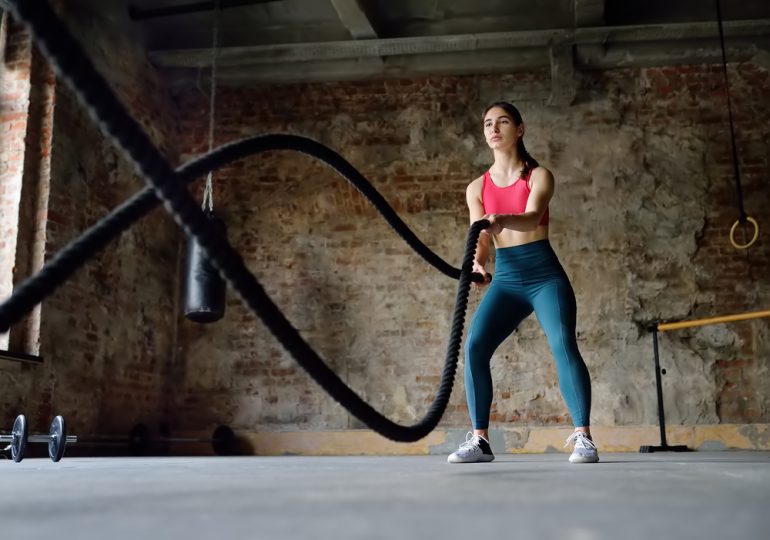The Science Behind HIIT Afterburn Effect
Is this reported benefit of high-intensity interval training too good to be true?
High-intensity interval training, known as HIIT, has become the “it” way to work out in recent years, as studios and gyms capitalize on the quick, effective method of training that alternates between bouts of intense activity—such as sprints—with periods of less-intense active recovery or complete rest. Fans of this super-efficient workout style swear by its ability to burn calories, target fat, and build muscle—all in much less time than a 5-mile moderate-intensity run.
Another purported benefit of HIIT is your body’s ability to stay in metabolism-boosting mode long after your workout. Known as HIIT afterburn, this process can boost your metabolism and keep you burning calories for up to 24 hours post-exercise. It’s a theory many HIIT-based studios tout as a major health benefit of their workouts, promising you’ll reap the benefits of their one-hour fitness classes for days.
But are these benefits too good to be true? Is the HIIT afterburn real? Here’s what science has to say about it.
HIIT Afterburn Effect, Explained
The afterburn process is scientifically known as excess post-exercise oxygen consumption (EPOC). It refers to the oxygen your body needs to restore itself to the pre-workout state—meaning your resting metabolism. Your body uses oxygen to produce fuel (scientifically known as adenosine triphosphate, or ATP) needed for your muscles to fire up during exercise; it can also call on stored energy sources that don’t require extra oxygen. HIIT workouts typically utilize the latter more than steady-state exercise does, and will also require more oxygen post-workout—this is why these short bursts of intense, taxing exercise are associated with the HIIT afterburn effect.
“Those [oxygen and calorie burn] go kind of hand in hand after exercise,” says Tedd Keating, Ph.D., C.S.E.S., associate professor of kinesiology at Manhattan College. “Your metabolism stays up for a period of time after exercise,” he adds. Although your body continues to burn calories after a workout, it’s usually only 6% to 15% of the total calories burned while exercising. So if you burned 300 calories during your workout, your afterburn would only be about 18 to 45. (Exercise isn’t the only way to maintain a high metabolism, BTW. Lifestyle changes such as eating sufficient protein might also help.)
EPOC is not limited to HIIT workouts—it’s present after all aerobic exercise—but the level of exercise intensity does play a role in just how many calories your body burns post-sweat. For low-intensity activity—say, a treadmill jog—you can expect a lower afterburn effect (about 6% calorie burn, toward the lower end of the range) but with HIIT workouts and exercises such as Tabata and speed drills, you could reap an afterburn closer to that 15% mark, reiterates Keating.
A few other factors alter your HIIT afterburn rewards: weight, fitness level, and muscle mass play a role. “People who are more aerobically fit, their bodies are going to be better fat burners as a whole,” says Keating. You can expect these people to have a more sustained HIIT afterburn effect.
Does HIIT Afterburn Last 24 Hours?
In short, the claim that your body continues to burn calories for up to 24 hours after a workout is deceiving. Although people who are more physically fit may derive longer benefits from EPOC, it’s usually only up to a couple of hours, tops.
A study from Colorado State University evaluated participants who performed sprint interval training and then measured their post-workout calorie burn. Although the results did show energy expenditure within 24 hours after the workout, most of the calorie burning was seen during and just after exercise, with the numbers dropping significantly from there. (And it should be noted that your body constantly burns energy and calories, even at rest.)
So does that mean the 24-hour afterburn effect is just a fairytale? “Never say never. There might be a really heroic exercise program that can do it,” says Keating. “But your typical high-intensity sprint interval stuff that’s being recommended now, like four 30-second bursts or something gentler like 10 one-minute bursts, probably aren’t going to give people that big 24-hour afterburn.”
HIIT Benefits Go Beyond the Afterburn
Even though HIIT is one of the most effective workouts to burn fat, the potential afterburn effect is just part of the puzzle, says Keating. During high-intensity workouts, your body produces more epinephrine and human growth hormone (HGH), which both have body-fat-reducing capabilities; one study found that a 30-second sprint on the stationary bike resulted in a nearly 450% increase in HGH production. Other benefits of HIIT include improved insulin sensitivity and blood pressure.
Interval training is also better at preserving lean body mass, says Keating. And the more muscle you have, the more calories you’ll burn while at rest. Plus, as you get more fit, you’ll increase your VO2 max, which is a number that indicates how efficiently your body uses oxygen during exercise.
The bottom line: While HIIT is a great way to get in shape, be wary of fitness studios promising to transform your body into a magical metabolism-boosting machine long after you towel off. That doesn’t mean you should ditch your favorite boot camp (remember, HIIT training still improves endurance and body composition), but the afterburn effect shouldn’t be the only reason you choose a specific workout type.

